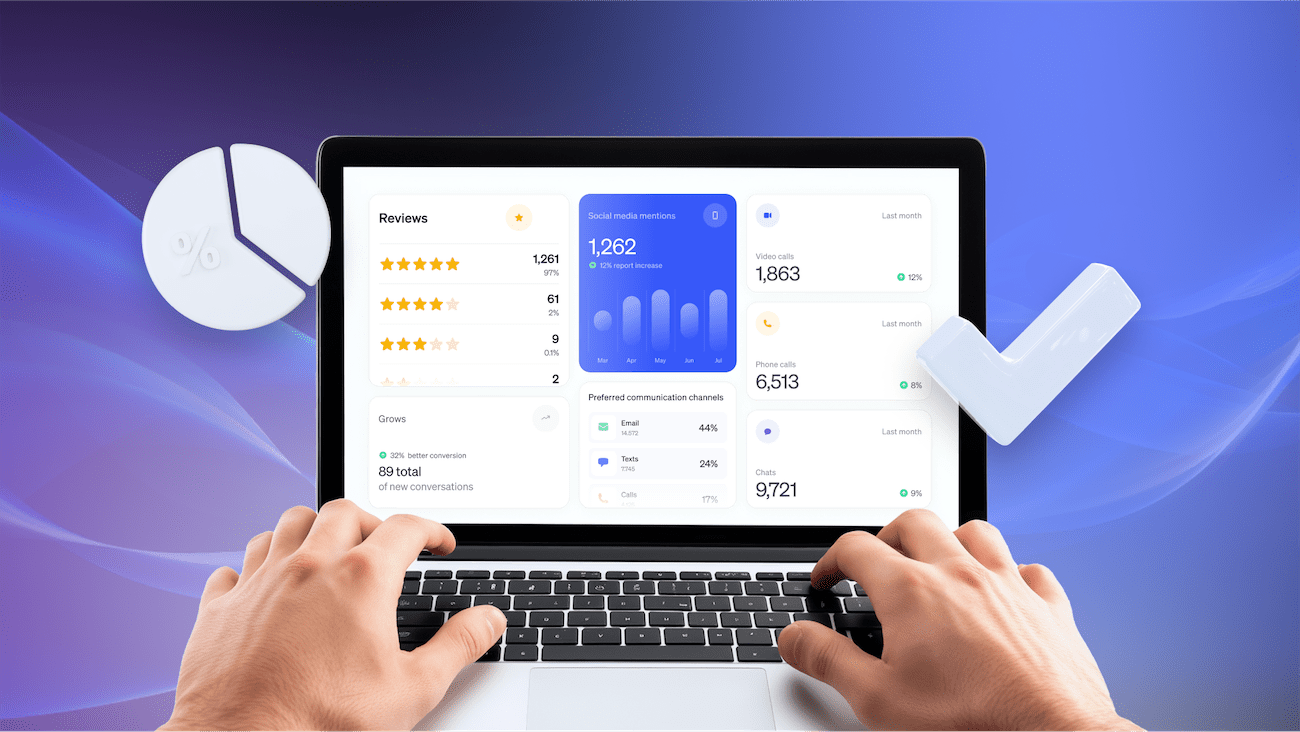Call center performance management metrics are key for success. The majority of customer interactions are with your call center agents, as they act as the frontline of your business. How these interactions are managed can significantly influence customer loyalty and brand perception.
Getting it right pays (literally).
Brands have known for a long time that customer service can be a differentiator. Ultimately, how well a call center performs can set a company apart from its competition. But only when done right.
In this guide, we introduce the call center performance methods and metrics that managers should use to create a positive work environment where agents not only meet but exceed customer expectations.
What Are the Core Constructs of Call Center Performance Management?
Below are the key elements guiding call center performance management.
Clear goal setting
Without clear direction and something to aim for, you’ll have no benchmark or target. Planning improved call center performance without goals can harm the overall process and hinder progress. Moreover, goals should be clear, measurable, and attainable.
When you have defined performance goals, you can tie them to key metrics that align with your business’s direction and ambitions. For example, if you know that customers feel you take too long to remedy problems, your goal could be to improve key performance indicators (KPIs) like:

Agent empowerment and training
When you have clear goals, you must provide agents with the necessary tools and training to support their development. Leaving agents to their own devices and expecting change is contrary to career and business development.
Instead, provide ongoing training and professional development to upskill agents. Then, once they’ve demonstrated a willingness to learn and a mindset geared toward continuous improvement, empower agents with the authority to make decisions that enhance the customer experience.

Effective leadership and coaching
Improvement in agent performance requires good leadership and coaching.
Note: Leading and coaching are different from managing, so they need different people skills. You can manage a team by pressing the right buttons and changing shift patterns. However, leading and coaching require specialist people skills.
Call center managers must build training programs that work toward a common goal as well as keep an eye on individual development. If one agent is flying through training faster than everyone else, perhaps there’s a more suitable course they could be put on. Doing so could fast-track their career and improve the business unit.
Likewise, if some agents are struggling, use regular feedback and performance reviews to coach them. Not everybody learns the same way, so it’s crucial to create a supportive environment where supervisors guide and mentor, not just manage.

Motivation and recognition
Contact center management isn’t just about managing queues and sending agents on training programs. It’s about ensuring each agent gets the appropriate encouragement along the way.
Some agents thrive on routine and autonomy, while others may need occasional guidance. If this is the case, implement incentive programs and gamification (bonuses, recognition, awards) based on individual and team performance. Make a judgment call about your team to see if public recognition will help those not performing up to standard keep up.

Workforce optimization
Ensuring you have the right agents in the right places at the right times is crucial to call center performance management. If your agents aren’t suited to the job at hand or you have too few agents working on inbound inquiries, customers won’t get the experience they desire.
To optimally manage rotas and shifts, use workforce management tools to help you understand your busy periods and seasonal trends. Armed with this data, plan best-case, worst-case, and most likely scenarios for your staff planning.
You should also factor in human elements and availability. Ensuring your employees are engaged and have work-life balance must be key components, as must talk time and agent skills.

What Call Center Metrics Should You Track?
Now that we’re familiar with the key principles of call center performance management, it’s time to introduce the metrics that will become your guiding lights. As your agents and department improve, expect to see an improvement in all the following areas.
Suggestion: Include all these metrics on your call center dashboards for optimum visibility.
Customer satisfaction
Businesses use customer satisfaction (CSAT) scores to measure how satisfied customers are with products, services, or interactions.
To measure CSAT, you must gather customer feedback by creating and circulating customer surveys. These can give you a numeric understanding of how customers feel about doing business with you.
A typical survey asks customers to rate statements on a scale of 0 to 10, with 0 representing ‘Not satisfied at all’ and 10 representing ‘Extremely satisfied’. To calculate your CSAT score, take the total number of satisfied or extremely satisfied customers and divide that figure by your total number of survey responses.

Net promoter score
Your net promoter score (NPS) calculates how likely customers are to recommend your service. NPS ranges from −100 to +100 and is often dubbed the gold standard customer experience metric.
It measures overall customer loyalty by asking how likely a customer is to recommend the service.
The core NPS question is ‘How likely are you to recommend our company to a friend or colleague?
Respondents can score questions between 0 and 10. A score of 0 means “Not at all likely,” and a score of 10 means “Extremely likely.”

To calculate your NPS, tally up all the responses and then calculate the percentages of ‘detractors,’ ‘promoters,’ and ‘passives.’
- A detractor is someone who responds with a score of 0-6.
- A promoter is someone who responds with a score of 9 or 10.
- A passive is someone who responds with a score of 7 or 8.
Next, subtract the detractor percentage from the promoter percentage. Passives are neither detractors nor promoters, so their scores don’t influence the overall score.

First call resolution
First call resolution (FCR) tracks the percentage of customer issues resolved during the first interaction. Often, by spending a little more time getting a thorough understanding of a problem, you fix the issue completely. This reduces the need for a customer to call back.
A lower FCR rate means you have many repeat callers and fewer happy customers. A higher FCR rate signifies better customer support and lower costs.

Average handle time
Average handle time (AHT) gives the average duration of a customer call, including talk time, hold time, and after-call work.
Important: Your AHT should strike a balance between avoiding rushed customer interactions and maintaining efficiency. Simply rushing through phone calls to improve this score will result in half-solved queries, a low FCR, and unhappy customers.

Service level
Service level refers to the percentage of calls that are answered within a specific timeframe (e.g., 80% of calls answered within 20 seconds). This metric is different from call volume, as it only concerns calls answered within that defined timeframe.
You might have a contractual or desirable internal service level you’re working toward to ensure customers aren’t waiting longer than is deemed acceptable.

Abandonment rate
The call abandonment rate is exactly what it says on the label. It measures the percentage of callers who hang up before reaching an agent. This could be for any number of reasons, which you could discover if you dig a bit deeper.
A high call abandonment rate may indicate understaffing or long wait times. It could also indicate that customers are impatient because they’re used to faster service elsewhere.

Agent utilization
Measuring the time agents spend actively handling calls versus idle time can reveal gaps in processes or areas that might benefit from further training. An agent utilization that’s too high or too low can signal issues with scheduling and staff levels or that your targets for metrics like service level and AHT may be incorrect.

Quality assurance scores
Call center quality assurance (QA) (also known as quality management) focuses on adherence to protocols and customer service standards.
QA teams review call recordings or live interactions to assess if agent performance is in line with expectations. During these call reviews, quality assurers are looking for adherence and displayed skills in the following categories:
- Verification: Did the agent authenticate the caller’s account access?
- Call management: Did the agent spot when they had to take urgent action?
- Call flow: Did the agent progress as per a predetermined script?
- Soft skills: How was the agent’s demeanor?
- Resolution: When the call was over, did the agent appropriately document the call?
Agent turnover rate
Call center turnover rate, especially regarding agents, can indicate whether your employees are engaged, have high job satisfaction, and enjoy good team stability. If your call center struggles with employee retention, it could indicate that your employees are unsatisfied.
If you’re churning contact center agents at an alarming rate, review what the root cause may be. Think about:
- Day-to-day employee experience
- Potential toxic influences
- Benchmarked salaries
- Employee workload
- Company culture

How to Improve Call Center Efficiency
Using key metrics to identify flaws and imbalances in your call center is only the first step. When you know what you need to work on, you can make the following four high-level changes to drive department-wide development.
Optimize your processes
Many call centers use outdated processes riddled with manual inefficiencies. By using the latest cloud contact center technology, you can reduce unnecessary steps when resolving customer issues.
Embrace automation and omnichannel support to streamline workflows, automate repetitive tasks, and offer new communication channels without asking customers to hold in long queues.
Add skill-based routing
Even the most basic phone system offers many call routing options. However, configuring call routing based on assumptions can be the downfall of many call centers.
Skills-based routing, which usually has interactive voice response systems integrated, uses information provided by a customer to connect them with agents who have specific skill sets needed to assist the customer. On the back end, you’ll assign skills to specific agents. This then routes calls based on ability as well as availability.
For example, if you serve banking customers and a client is seeking someone to help reverse a charge processed due to a system error, your skills-based routing system should find an agent who is authorized and equipped with the right tools to process a refund.

Provide effective training and onboarding
It should go without saying that high-quality training and onboarding set a level of expectation and encourage career and personal development.
The key takeaway here is that you must regularly update agent training to reflect product changes, customer expectations, and evolving company policies. Stagnant training sessions and coaching tactics that worked several years ago will be inefficient now and waste everyone’s time.
Set up cross-channel integrations
Multichannel contact centers have now been around for years. While some businesses have legitimate reasons for remaining voice-only, the vast majority simply haven’t had the time or guidance to implement new channels.
By introducing email, web chat, SMS, or social media, customers have alternative channels to reach your business. This doesn’t just free up call queues and reduce hold time; it also improves customer experience, as the decision of which channel to use is made by customers.
Not everyone is comfortable on the phone. And many customers will be multitasking, meaning holding for an agent isn’t their priority. You can remedy this problem by introducing newly supported digital channels.
How Call Center Software Can Help
No call center can truly thrive using only a phone system and manual processes. Changing from a bit-part solution to a modern cloud call center could be the difference between nailing call center performance management and losing your most valuable customers to a competitor.
Performance dashboards
Having a holistic view of each department, user, queue, and metric means you’re one step closer to improving your call center operation. However, the sheer volume of trackable KPIs can lead to some dashboards becoming overwhelming.
As such, you can utilize call center software with customizable dashboards that provide insights into real-time performance metrics for both agents and managers. When configuring your dashboard, you’re able to pick and choose what’s most important (or what’s most important right now).

Workforce management tools
Workforce management (WFM) tools help automate scheduling, shift adjustments, and forecasting to ensure optimal staffing and reduce idle time. While some call centers still swear by the Erlang calculator, it doesn’t factor in unplanned changes, absenteeism, or human elements like burnout or workload.
When you treat WFM with the respect and importance it warrants, you get many things right in your business, not just call center operations. And from a customer point of view, you’ll achieve optimal service quality. When customers phone in, they’ll get through to an agent — and the right agent, too — without waiting a long time.

Deep customer relationship management integration
Integrated customer relationship management (CRM) systems give agents a complete view of a customer’s history and interactions, thus reducing time spent searching for information and improving service quality.
Rather than switching between apps, duplicating information, and relying on manual processes, agents get everything they need in a single interface. This way, they can dedicate more time to helping customers and less to doing needless admin.

Call recording and transcription tools
For QA, the minimum requirement should be call recording. However, reviewing each call individually is cumbersome and time-consuming.
You can now use built-in transcription software to identify which calls need the most attention, removing the need to review good calls that don’t need your time.
With artificial intelligence (AI) components like sentiment analysis and auto-grading, you get access to speech analytics that speed up the process. If a customer on a call gets flagged as unhappy or an angry or frustrated sentiment is detected, you can choose to prioritize reviewing those calls.
Even if this is happening in real time, supervisors can get notified and choose to intervene to diffuse the situation.

Improve Contact Center and Agent Productivity With Nextiva
There’s a lot to digest when thinking about contact center performance management.
It’s likely that your business will change a lot. You’ll need to introduce new metrics, gain buy-in to change (and optimize) the process, and likely update your software.
What you need in your corner is Nextiva’s comprehensive software platform:
- You get access to hundreds of metrics, reports, and analytics out of the box.
- You get features like dashboards, omnichannel, and sentiment analysis straight away.
- You don’t need to bolt on extra software for WFM or CRM.
It’s simple to use and comes with hands-on onboarding to improve performance, which is vital when making any change in a business.
The biggest contributor to pushback in any organization is the time and energy needed to set up a new system. That’s why Nextiva prioritizes both the user and customer experiences — and customers love us for it!

“A system migration is never easy — unless you have the right partner. That’s where Nextiva came in. The transition to Nextiva offered increased operational efficiency, improved mobility and flexibility, and reliable and secure communication.”
Chris Monroe
Ready to improve your call center performance? Check out Nextiva’s AI-powered Unified-CXM platform here. 👇
Build Amazing Customer Experiences
Transform customer experience on a Unified Customer Experience Management platform designed to help you acquire, retain, and grow your customers.

















 Productivity
Productivity 







